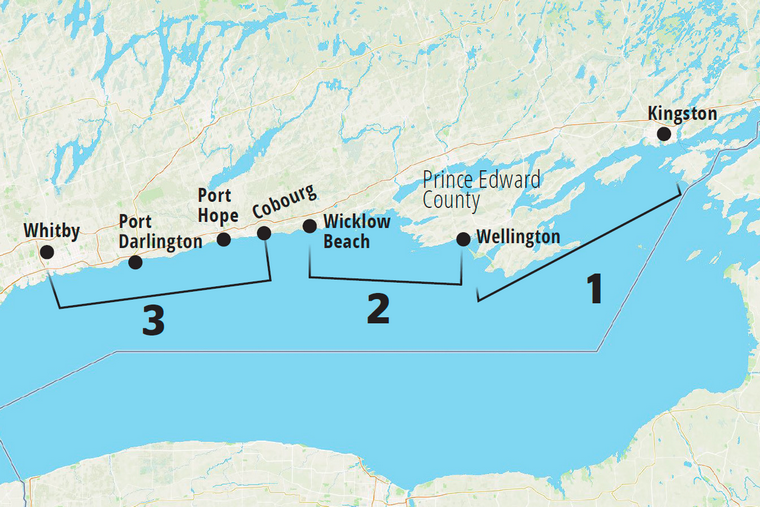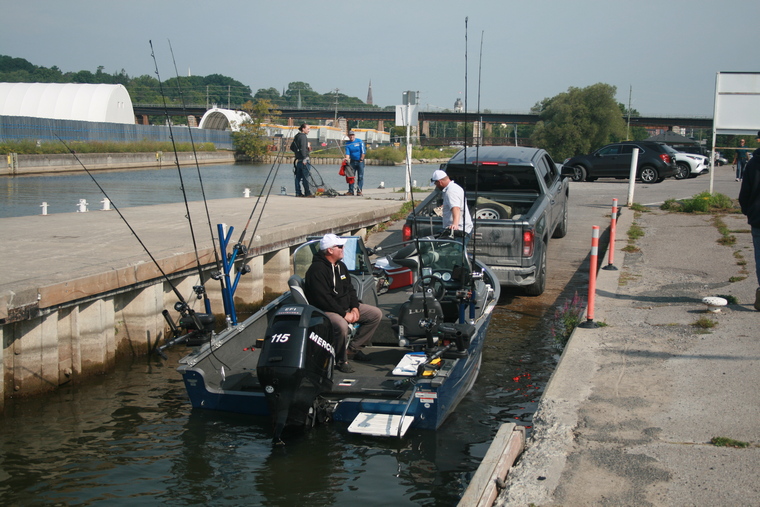Salmon and trout anglers used to concentrate their efforts on western Lake Ontario, from Scarborough to Port Dalhousie. Over the last couple of decades, however, the lake’s eastern basin has been getting much more attention.
Launch ramps from Whitby to Kingston offer an entry point for excellent fishing. Chinook and coho salmon, steelhead, brown, and lake trout are all target species. And each section of the approximately 200 kilometres of shoreline on this side of the lake has its own unique angling attributes.
Here’s what you need to know to take advantage of this robust fishery.
Eastern Lake Ontario is a laker hotspot. Clients of Mike Tschakovsky, who operates All The Rage Charters, (alltheragesportfishing.com), had an outstanding year in 2023. Spring and winter often produced 40 to 50 lakers on an eight-hour charter and on good summer days in July, clients landed more than 20.
“As soon as the ice disappears and allows us to launch, we fish the waters around Amherst Island’s western and eastern ends,” he said. “As the water warms over the end of March to the end of May, laker action shifts towards the shoals in open water to the south, including Big Bar Shoal, Pigeon Island Shoal, and even further out to the main Duck Islands.”
Finkle’s launch near Bath is popular and close to Amherst Island. It stays reasonably ice free. “From June to September, lake trout hold at depths from 70 to 120 feet near structure to adjacent flats. Depending on water temperature, planer boards with lead core, Dipsy Divers, and downriggers are effective. A small laker would be six to nine pounds with our average laker between 10 and 12 pounds,” Tschakovsky added.

Anglers are drawn to this section of shoreline due in large part to the concentration of underwater structure that attracts fish. The Prince Edward County headland extends out into Lake Ontario, forming islands and shoals.
In April and May, salmon concentrate in the southwest corner of the lake due to warmer temperatures and prey fish concentration created by inflow from the Niagara River. Chinook and coho start to migrate in an easterly direction along the US shoreline and then some turn north to the Prince Edward County shoreline in early June. This migration repeats each year with some minor variations based on weather.
Scott Walcott operates Bay of Quinte Charters, (bayofquintecharters.com) and utilizes Wellington as his home port for salmon charters.
“Usually, anglers start to focus on the area from about the middle of June through to about the third week in August,” he said, citing a “string of structure” west of Wellington that includes Nicholson Island and to the south, Scotch Bonnet Island and Scotch Bonnet Shoal. Palen Bank and McFaul Shoal are also good locations.
“In general, I find 100 to 125 feet of water is a good depth to fish earlier in the year, closer to the structure, and as the season progresses go deeper,” Walcott added. “I’m a fan of diversity so I use copper, lead core, divers, and downriggers and they all produce.”

You can reach Scotch Bonnet Island from either Wellington or Brighton, but the prevailing southwest winds make going back to the launch at Wellington easier. Further west along the shoreline near Colborne is the launch at Wicklow. It is a great ramp with reasonable access to the shoal known locally as Mulcaster Patch.
Mixed in with the salmon is a combination of rainbow trout, browns, and lakers. Browns and lakers are usually incidental catches, but the rainbows can be targeted with lines fished higher than for salmon.
This shoreline is very popular as a result of excellent launch ramps and nearby facilities. It’s also produced at least half of the weekly leaderboard prize winners in both the Silver Salmon Challenge and Great Ontario Salmon Derby over the past few years. Streams and rivers that attract mature salmon include the Ganaraska River and Wilmot, Bowmanville, and Oshawa creeks.
Chinook usually arrive in mid-June and stay in the area until mid-September. The latter part of the season is extended because of the large numbers of pre-spawn chinook staging off major rivers. This section of eastern Lake Ontario has phenomenal rivermouth fishing from boats and great pier fishing starting the last week in August.
Proximity to Toronto and Whitby/Oshawa offers a variety of services and accommodations. There is also a wide range of charter boat operators for a day on the water.
For a first timer, it’s key to learn the differences between nearshore and offshore (10 kilometres or more) patterns. In the summer, warm shoreline water can push the fish out a considerable distance from shore.
Brian Stubbings, who operates Salmon Master Fishing Charters (salmonmaster.ca) out of Whitby, is a firm believer in educating all his clients about salmon and trout behaviour.
“From Cobourg to Whitby, you really need to pay attention to wind direction, water temperatures, and currents,” he said.
One key element is to define “subtle” structure which could be as simple as a small trench, bowl or hump, Stubbings added. “Another suggestion is to not ignore the evening bite which in this area can be as good as, or better, than early morning.”
Overall, eastern Lake Ontario has much to offer anglers. The potential for excellent salmon and trout action is only a short drive down the 401.

Originally published in the August 2024 issue of Ontario OUT of DOORS



Contact Information
PO Box 2800 / 4601 Guthrie Dr.
Peterborough, Ontario Canada K9J 8L5
Phone: 705-748-OFAH (6324)
Fax: 705-748-9577
Join Our Newsletter
Watch
Shop
Follow